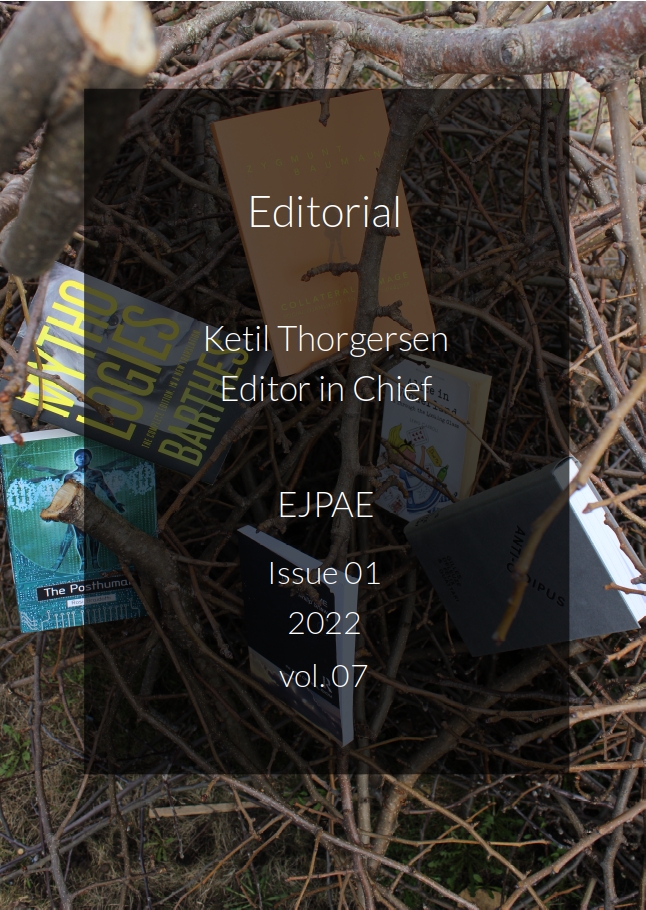Editorial for the European Journal of Philosophy in Arts Education
vol 07 2022 01
Abstract
EJPAE is happy to publish a new issue with fresh perspectives in the intersection between learning/education, the arts/aesthetics, and philosophy/theory. It feels good, and at the same time strange, to publish articles about learning and the arts in a European journal, when at the same time Europe is at war. In a situation where Putin, an anti-democratic despot, invades a neighbouring country, killing and torturing innocent people, learning and the arts may seem trivial. It is my absolute belief, however, that in times of despair, the arts are seminal in creating meaning for people, both on a personal level and on a societal level. One of my favourite explanations to what purpose art has, comes from Deleuze and Guattari’s book What is Philosophy, where they suggest that art is supposed to offer genuinely new perspectives to the world. Art is this book compared with science and philosophy – all three human activities that aim to construct meaning, albeit with complementary purposes: Philosophy should aim to propose new terms that will allow for new ways of thinking about the world, science should pick the world apart to make visible the parts from which (parts of) the world are becoming, and art aims to present whole new worlds for us that may lure us into turning our world-views around. EJPAE is a journal that combines these three human endeavours for meaning-making. Articles presented here should therefore both deconstruct, create, and suggest new ways of thinking about the world. What could be more appropriate in times of confusion and turbulence?
This time, the issue comprises of three articles with very different perspectives and topics: Texture matched with phenomenology; Ethics in music education matched with Martha Nussbaum; Practising in music matched with ancient Greek philosophy and again Nussbaum. There are altogether five authors writing these three articles, from Greece, Norway and Sweden.
The first article is an intriguing dive into a pool of texture. Eva Alerby and Kari Doseth Opstad discuss how the arts can understand learning in the arts through how we sense the world as and with texture. To discuss this, they employ the theoretical arsenal of Dufrenne and Merleay-Ponty. “[…] texture is the difference that makes the difference”, they write and argues that there is nothing that can be experienced or thought that is not sensed – and sensing involves texture. In the article, we meet a student group that experience working with texture, mixed with philosophical reflections on aspects of learning in and through texture. And in the end, it becomes clear that “[...] texture encourages or brings out the attention, awareness and sensitivity that are of significance not only for (arts) education, but also for the formation of society—for the formation of our lives.”
The second article also reports on student work. Theocharis Raptis. The article Emotions in music education as an ethical issue reflect over ethical issues of working with emotions in kindergarten music education. Nussbaum is used to talking about how students and teachers can construct an education that strengthens the emotional competence of kindergarten teacher students – and in turn the children and herein also citizens. As Raptis argues, emotions are central to why music is important, and also that psychological research shows that music inflicts emotions. On the surface, this may seem trivial, but how should and could teachers deal with the more problematic feelings that could arise in a child? What if music opens up for trauma or sets off aggression? Raptis argues convincingly that through conscious and careful music educational work, children can learn to become aware of their emotions and learn to deal with and trust even the more problematic ones.
The third article in this issue is by Robin Rolfhamre and Inga Marie Nesmann-Aas. The article Rethinking Music Practise-Sessions beyond Poiesis and Praxis – Towards Practising Democracy makes the somewhat unexpected connection between practising an instrument and a democratic society. The act of practising music was for long a blank page in the annals of music education. Everyone knew that much practise was needed, but how to teach practising skills, and what constituted such skills was a mystery to those who had not miraculously discovered it somehow. The last thirty or so years, this has changed and there is now quite a lot of research on how to practice and how much one should practice. However, practising a music instrument or song in formal music education, is still oftenmost acting in solitude. This article takes tries out a more collective approach to practising: One that the authors argue will not only make individuals great musicians, but will also help develop a healthy democratic society.
I have really enjoyed challenging myself in the meeting with these articles, and I hope you will too.
Ketil Thorgersen
Editor in Chief Stockholm May 10th 2022

Downloads
Published
Issue
Section
License
Copyright (c) 2022 Editor in Chief

This work is licensed under a Creative Commons Attribution 4.0 International License.
EJPAE provides immediate open access to all its published content. Users do not need to register or pay to read content.
https://creativecommons.org/licenses/by/4.0/
Authors of content published in European Journal of Philosophy in Arts Education (EJPAE) retain the copyright to their works. Content is free to be used by anyone as long as you "[...] give appropriate credit, provide a link to the license, and indicate if changes were made. You may do so in any reasonable manner, but not in any way that suggests the licensor endorses you or your use." and "No additional restrictions — You may not apply legal terms or technological measures that legally restrict others from doing anything the license permits." (from the Creative Commons licence agreement)
EJPAE does not charge any author or publication fees.
Authors are encouraged to deposit the final published version of their article for self-archiving (author's personal website) and/or archiving in an institutional repository immediately upon publication.




